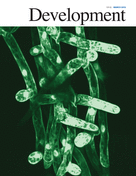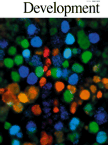Selected Publications
Interleukin-6 signaling mediates cartilage degradation and pain in posttraumatic osteoarthritis in a sex-specific manner
(2022) Science Signaling 15(744): eabn7082
Liao Y, Ren Y, Luo X, Mirando AJ, Long JT, Leinroth A, Ji RR, and Hilton MJ.
This publication demonstrates that genetic ablation of Interleukin-6 (IL-6) alleviates both the cartilage degeneration and pain associated with post-traumatic osteoarthritis (PTOA); however, does so in a sex (male) specific manner. This work identifies IL-6 and downstream effectors such as the Janus Kinases (JAKs), Signal Transducer and Activator of Transcription 3 (STAT3), and the Extracellular Signal-Regulated Kinases (ERK1/2) as specific mediators of PTOA-associated cartilage degradation and pain. These findings have significant implications for IL-6 as a common culprit and potential comprehensive (pain and cartilage degeneration) target as a DMOAD therapy, while also being one of the first reports to detail sex specific mechanisms underlying the pathobiology of PTOA. This work was also highlighted by Science Signaling with a “Focus” commentary, “Osteoarthritis and chronic pain: Interleukin-6 as a common denominator and therapeutic target”. Cover Image. It also serves as the most recent publication in a series of collaborative studies between my lab and Dr. Ru-Rong Ji (Duke Center of Translational Pain Medicine) related to the identification of molecular mediators of chronic musculoskeletal pain.
Identification of distinct non-myogenic skeletal-muscle-resident mesenchymal cell populations.
(2022) Cell Reports 39(6):110785.
Leinroth AP, Mirando AJ, Rouse D, Kobayashi Y, Tata PR, Rueckert HE, Liao Y, Long JT, Chakkalakal JV, and Hilton MJ.
This publication was the first to identify several non-myogenic mesenchymal cell populations localized within skeletal muscle tissue that have specific differentiation capacities, unique responses to chronic and acute muscle injuries, and/or distinct localizations that include perineural and perivascular niches. Detailed characterizations and the development of new tools to identify, sort, and genetically target these populations have provided a foundation for future research into the behavior and function of these cells during skeletal muscle development, injury, and regeneration, as well as in neuromuscular diseases, such as the muscular dystrophies. This study is the inaugural publication representing a new transition for some of my research focus into the areas of skeletal muscle development, regeneration, and disease.
Hypertrophic chondrocytes serve as a reservoir for marrow-associated skeletal stem and progenitor cells, osteoblasts, and adipocytes during skeletal development.
(2022) eLife doi:10.7554/eLife.76932.
Long JT, Leinroth A, Liao Y, Ren Y, Mirando AJ, Nguyen T, Guo W, Sharma D, Rouse D, Wu C, Cheah KSE, Karner CM, and Hilton MJ.
This publication was the first to demonstrate that hypertrophic chondrocytes of the cartilage growth plate alter their cell fate by first dedifferentiating into populations of SSPCs, one of which is known as CXCL12-abundant reticular (CAR) cells, prior to their redifferentiation into osteoblasts (bone cells) and adipocytes (fat cells) within the bone marrow. This represents a paradigm shift away from our prior understanding of hypertrophic chondrocytes; one in which hypertrophic chondrocytes only indirectly supported endochondral bone formation by secreting factors that promote bone marrow vascularization, osteoblast recruitment, and bone formation prior to undergoing apoptosis to leave behind an extracellular matrix scaffold utilized by the migrating osteoblasts.
HES1 is a novel downstream modifier of the SHH-GLI3 axis in the development of preaxial polydactyly
(2021) PLoS Genetics 17(12):e1009982.
Sharma D, Mirando AJ, Leinroth A, Long JT, Karner CM, and Hilton MJ
Utilizing genetic and molecular approaches, in this publication we identified HES1 as a key transcriptional regulator downstream of Sonic Hedgehog (SHH/GLI) signaling capable of inducing preaxial polydactyly (PPD; extra fingers and toes), required for Gli3-deficient PPD, and sufficient to compensate for the digit number constraints of Shh-deficiency. While several SHH/GLI3 regulated genes in this setting have been identified, few have been directly implicated as critical regulators of SHH/GLI3-mediated digit development. This is especially true for target genes that don’t simply “feed-back” to regulate Shh expression, and no factors had been identified that were sufficient to compensate for Shh-deficiency. We view these findings as landmark discoveries in skeletal development and limb patterning.
HES Factors Regulate Specific Aspects of Chondrogenesis and Chondrocyte Hypertrophy During Cartilage Development
(2016) Journal of Cell Science 129(11): 2145-55
Rutkowski TP, Kohn A, Sharma D, Ren Y, Mirando AJ, and Hilton MJ.
This publication is the first to describe precisely how specific HES factors regulate cartilage development. We developed unique in vivo genetic models and in vitro approaches to demonstrate that the RBPjκ-dependent Notch targets HES1 and HES5 suppress chondrogenesis and promote the onset of chondrocyte hypertrophy. HES1 and HES5 might have some overlapping function in these processes, although only HES5 directly regulates Sox9 transcription to coordinate cartilage development. HEY1 and HEYL play no discernable role in regulating chondrogenesis or chondrocyte hypertrophy, whereas none of the HES or HEY factors appear to mediate Notch regulation of cartilage matrix catabolism during development. This work identifies important candidates that might function as downstream mediators of Notch signaling both during normal skeletal development and in Notch-related skeletal disorders.
NOTCH Signaling in Skeletal Progenitors is Critical for Fracture Repair
(2016) Journal of Clinical Investigation doi:10.1172/JCI80672
Wang C, Inzana JA, Mirando AJ, Ren Y, Liu Z, Shen J, O'Keefe RJ, Awad HA, and Hilton MJ.
This publication is the first to describe how NOTCH signaling within bone marrow stromal/stem cells (BMSCs) and BMSCs themselves are critical for normal fracture healing. Our data demonstrate that if NOTCH signaling is defective specifically within BMSCs, the BMSC population is depleted and/or defective resulting in severely compromised healing and fracture nonunions. Finally, our NOTCH defective BMSC animal model demonstrated an ability to produce a fracture nonunion irrespective of fracture stability and without any signs of altered vascular involvement, two very important and common causes for fracture nonunions. These data suggest that NOTCH signaling status within BMSCs and BMSC populations themselves could serve as predictors for those fractures that heal successfully and those that proceed to a nonunion.
A Dual Role for NOTCH Signaling in Joint Maintenance and Osteoarthritis.
(2015) Science Signaling 8(386): ra71.
Liu Z, Chen J, Mirando AJ, Wang C, Zuscik MJ, O'Keefe RJ, and Hilton MJ.
This publication describes how NOTCH signaling strength, duration, and context in joint cartilages mediates the balance between joint maintenance and osteoarthritis. We demonstrate that transient activation of NOTCH signaling in the joint cartilages favors normal physiology and maintenance and that sustained or pathological NOTCH signaling is capable of inducing osteoarthritis, independent of other external factors. This study is the first to reconcile how NOTCH signaling is both required for joint maintenance and capable of inducing joint disease. Furthermore, this work identified novel targets of the NOTCH signaling pathway in chondrocytes that mediate some of the destructive effects of sustained NOTCH signaling on joint tissues, and has therefore implicated these molecules as potential disease modifying osteoarthritis drug (DMOAD) targets.
Notch Signaling Controls Chondrocyte Hypertrophy via Indirect Regulation of Sox9.
(2015) Bone Research 3: 15021.
Kohn A, Rutkowski TP, Liu Z, Mirando AJ, Zuscik MJ,O'Keefe RJ, and Hilton MJ.
This publication describes the molecular mechanism by which the RBPjk-dependent Notch signaling pathway controls the onset of chondrocyte hypertrophy. We demonstrate that RBPjk-dependent Notch signaling indirectly suppresses Sox9 expression via secondary effectors, which are likely members of the HES/HEY transcription factor family. Furthermore, we demonstrate that this regulation coordinates the onset of chondrocyte maturation, but has no effect on terminal chondrocyte hypertrophy and cartilage matrix turnover.
Transient Gamma-Secretase Inhibition Accelerates and Enhances Fracture Repair Likely Via Notch Signaling Modulation.
(2015) Bone 73: 77-89.
Wang C, Shen J, Yukata K, Inzana JA, Mirando AJ, O'Keefe RJ, Awad HA, and Hilton MJ.
This publication describes a novel therapeutic strategy for acclerating and enhancing skeletal fracture repair. We demonstrate that transient, but not sustained, gamma-secretase and Notch inhibition promotes and acclerates fracture repair via the enhanced differentiation of skeletal progenitors. This study is the first to demonstrate that the gamma-secretase and Notch inhibitor, DAPT, can be utilized in the context of skeletal regeneration and repair and serves as a proof-of-concept for further exploration of these drugs in translational studies.
NOTCH-Mediated Maintenance and Expansion of Human Bone Marrow Stromal/Stem Cells: A Technology Designed for Orthopedic Regenerative Medicine.
(2014) Stem Cells Translational Medicine 3(12): 1456-1466.
Dong Y, Long T, Wang C, Mirando AJ, Chen J, O'Keefe RJ, and Hilton MJ.
This publication describes a novel biological method that entails selection of human BMSCs based on NOTCH2 expression and activation of the NOTCH signaling pathway in cultured BMSCs via a tissue culture plate coated with recombinant human JAGGED1 (JAG1) ligand. We demonstrate that transient JAG1-mediated NOTCH signaling promotes human BMSC maintenance and expansion while increasing their skeletogenic differentiation capacity, both ex vivo and in vivo. This study is the first of its kind to describe a NOTCH-mediated methodology for the maintenance and expansion of human BMSCs and will serve as a platform for future clinical or translational studies aimed at skeletal regeneration and repair.
Skeletal Development and Repair: Methods and Protocols
(2014) Methods in Molecular Biology
Editor: Matthew J. Hilton
This volume, Skeletal Development and Repair, in the Methods in Molecular Biology series is designed as a comprehensive laboratory manual for all levels of basic research scientists working in the broad fields of skeletal development and skeletal repair research. The protocols highlighted here not only encompass the most current and cutting-edge techniques in skeletal development and repair, but also showcase those protocols that have been modified and perfected over the course of several decades of skeletal research. Three chapters from this work were developed directly by the Hilton Laboratory.
RBPjκ-dependent Notch signaling is required for articular cartilage and joint maintenance.
(2013) Arthritis and Rheumatism. 65(10):2623-2633.
Mirando AJ*, Liu Z*, Moore T, Lang A, Jesse AM, Kohn A, O’Keefe RJ, Mooney RA, Zuscik MJ, and Hilton MJ.
This publication is the first to indicate that the RBP-Jκ–dependent Notch pathway is a novel pathway involved in joint maintenance and articular cartilage homeostasis, a critical regulator of articular cartilage ECM-related molecules, and a potentially important therapeutic target for OA-like joint disease.
Cartilage-specific RBPjκ-dependent and -independent Notch signals regulate cartilage and bone development.
(2012) Development. 139(6): 1198-212.
Kohn A, Dong Y, Mirando A, Jesse AM, Honjo T, Zuscik MJ, O’Keefe RJ, and Hilton MJ.
This publication was the first to demonstrate that Notch regulation of chondrocyte maturation is solely mediated via the RBPjκ-dependent pathway, and that the perichodrium or osteogenic lineage influences chondrocyte terminal maturation. Furthermore, we identified the cartilage-specific RBPjκ-independent pathway as a critical regulator of chondrocyte proliferation, survival, and columnar chondrocyte organization. We also identified RBPjk-independent signals as an important long-range cell non-autonomous regulator of perichondral bone formation that corrdinates chondrocyte and osteoblast differentiation during skeletal development.
RBPJk-dependent Notch Signaling Regulates Mesenchymal Progenitor Cell Proliferation and Differentiation During Skeletal Development.
(2010) Development. 137(9): 1461-1471.
Dong Y*, Jesse A*, Kohn A, Gunnell LM, Honjo T, Zuscik MJ, O’Keefe RJ, and Hilton MJ.
This publication demonstrates for the first time that the RBPjkappa-dependent Notch signaling pathway is a crucial regulator of mesenchymal progenitor cell (MPC) proliferation and differentiation during skeletal development. We also implicated the Notch pathway as a general suppressor of MPC differentiation that does not bias lineage allocation. Finally, Hes1 was identified as an RBPjk-dependent Notch target gene important for MPC maintenance and the suppression of in vitro chondrogenesis.
Notch Signaling Maintains Bone Marrow Mesenchymal Progenitors by Suppressing Osteoblast Differentiation.
(2008) Nature Medicine. 14 (3): 306-14.
Hilton MJ*, Tu X*, Bai S, Zhao H, Kobayashi T, Kronenberg HM, Teitelbaum SL, Ross FP, Kopan R, and Long F.
This publication was the first to demonstrate the importance of Notch signaling in bone marrow mesenchymal progenitor cells. Our data support a model wherein Notch signaling in bone marrow normally acts to maintain a pool of mesenchymal progenitors by suppressing osteoblast differentiation. Thus, mesenchymal progenitors may be expanded in vitro by activating the Notch pathway, whereas bone formation in vivo may be enhanced by transiently suppressing this pathway.
















